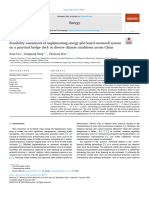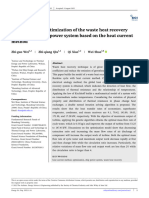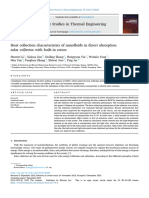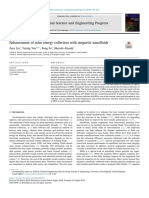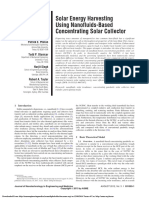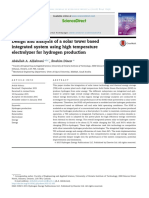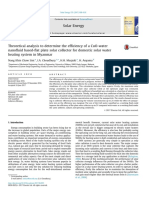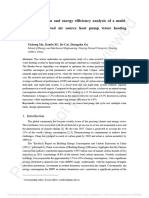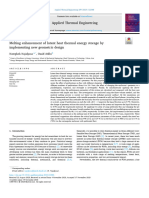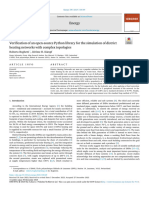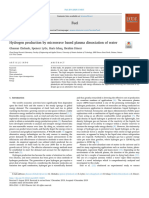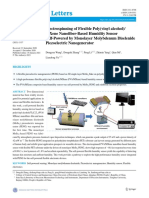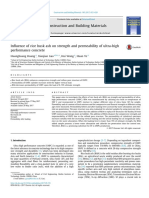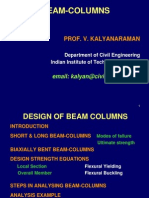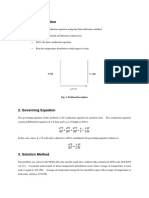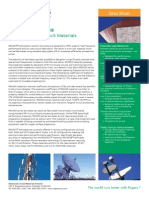POWER2016-59259: Numerical Modeling of Liquid-To-Vapor Phase Change in Porous Medium Under Solar Heat Localization
POWER2016-59259: Numerical Modeling of Liquid-To-Vapor Phase Change in Porous Medium Under Solar Heat Localization
Uploaded by
Friday Niyehmi Abolorunke ChristopherCopyright:
Available Formats
POWER2016-59259: Numerical Modeling of Liquid-To-Vapor Phase Change in Porous Medium Under Solar Heat Localization
POWER2016-59259: Numerical Modeling of Liquid-To-Vapor Phase Change in Porous Medium Under Solar Heat Localization
Uploaded by
Friday Niyehmi Abolorunke ChristopherOriginal Title
Copyright
Available Formats
Share this document
Did you find this document useful?
Is this content inappropriate?
Copyright:
Available Formats
POWER2016-59259: Numerical Modeling of Liquid-To-Vapor Phase Change in Porous Medium Under Solar Heat Localization
POWER2016-59259: Numerical Modeling of Liquid-To-Vapor Phase Change in Porous Medium Under Solar Heat Localization
Uploaded by
Friday Niyehmi Abolorunke ChristopherCopyright:
Available Formats
Proceedings of the ASME 2016 Power Conference
POWER2016
June 26-30, 2016, Charlotte, North Carolina
POWER2016-59259
NUMERICAL MODELING OF LIQUID-TO-VAPOR PHASE CHANGE IN POROUS
MEDIUM UNDER SOLAR HEAT LOCALIZATION
Hamidreza Ghasemi Bahraseman, Ehsan Mohseni Languri1
Department of Mechanical
Engineering,
Tennessee Tech University
Cookeville,
TN, USA
ABSTRACT solving the governing equations. The mass transfer along with
the fluid flow and heat transfer then solved. The simulations
Evaporation process is a crucial part of many fundamental were done under different conditions including the hour
industrials and medicals process. This paper numerically model distribution of irradiation in an average summer day and winter
a novel method of steam generation and enhanced evaporation day to estimate steam generation rate. Produced vapor were from
using solar thermal energy. In this model, a capillary-raised fluid 13.96 kg/m2 to 18.95 kg/m2 in typical summer and winter days,
flows through a porous medium under localized heating respectively. The results show a temperature changes between
condition, and the phase change from liquid to vapor at the 26.9°C and 54.4 °C. Development of the 3D numerical model
liquid-vapor interface occurs. The hydrophilic porous material and its implementation in existing data facilitates better
facilitates the capillary forces for better transportation of the bulk understanding of the transport phenomena through the porous
water through the porous media to the surface of porous media media.
where the absorbed solar energy deliver to the amount of water
inside the pores. The high capillary force due to the micro size INTRODUCTION
inter connected pores inside the medium will rise the fluid from
the cold bulk reservoir and the highly concentrated solar Despite progress in harvesting available renewable energy
radiation focused inside the medium will evaporates the liquid sources for industrial applications, the solar energy harvesting
very effectively. Based on this approach, the absorbed solar and utilization require significant improvement in terms of
energy is delivered into the specific small pores of porous media technical, durability, controls and cost [1]. Solar radiation can be
that initiate the localized evaporation process. The steam utilized to generated steam or vapor for many residential and
generated from this economical technique could be used greatly industrial applications including power generation, desalination,
for thermal solar desalinations process, sterilization process, etc. sterilization, and water purification [2-4]. The traditional
A CAD model of such porous media was developed using methods to generate steam from solar energy include the use of
SolidWorks package. The mesh will be generated on the CAD a solar absorber that gains the thermal energy from the sun
file and the model was imported into the ANSYS Fluent for radiation and a secondary loop of a fluid transfer this heat into a
1
Corresponding Author: Ehsan Languri, ELanguri@tntech.edu, (931) 372-6790.
1 Copyright © 2016 by ASME
Downloaded From: http://proceedings.asmedigitalcollection.asme.org/pdfaccess.ashx?url=/data/conferences/asmep/90179/ on 04/11/2017 Terms of Use: http://www.asme.org/abo
bulk cold fluid for heating and steam generation [5]. The optical carbon-foam to localize heat at the interface of graphite and
losses defined as the ratio of solar gain to its outcome that is carbon foam approximately. Computational methods have the
generated steam in this case [5]. The high optical losses (the potential to predict the vaporization through porous media due
losses of solar radiation) and high cost associated to the to heat flux like solar thermal energy, provided the correct
traditional methods of steam generation hinder their application boundary conditions were applied. Many physical influences
in industry as a dependable source of steam generation [5]. must be concerned such as fluid flow, heat transfer, and transport
Several other existing technologies for vapor generation are of participating liquids as well as gases. However, concentrating
nuclear and fossil fuel steam generation for power generation [6], the solar energy at the interface of evaporation at modified
thermal collector systems for low temperature steam generation porous media and solar flux, to avoid heating the entire bulk fluid
[7] and parabolic troughs for direct steam generation [8]. All of would reduce the disadvantages including heat loss [5].
the above-mentioned techniques and technologies require large Moreover, concerning the fact that experimental methods are
scale with low efficiency and high cost that makes them difficult, expensive, and may have risks however computational
unattractive and unreliable to many industries [9, 10]. methods have the potential to determine this idea diminishing the
To overcome the shortcomings associated to the traditional need to start with experimental procedures.
methods of solar steam generation and evaporation, few The goal of this study is to perform a three-dimensional
researchers in recent years have been studying the use of numerical study on solar heat localization utilizing the
nanomaterials and porous medium with customized thermal and nanoporous medium at the interface of water and air for steam
physical properties in steam generation. In recent years, generation and enhanced evaporation. The geometry of the
Neumann et al. [11-12] prospered to generate steam in bulk of computational domain and material properties were taken from
water with applying Au nanomaterials. Nonetheless, the Ref. [5]. The numerical testing has been done under various solar
efficiency of solar-thermal conversion of this approach was radiation concentrations as well as boundary conditions. For
around 24%. The application of these methods in standalone more practical applications and conclusion, an hourly irradiation
compact solar systems was limited by the high optical in a typical summer day and winter day was imposed to model’s
concentrations. Additionally, high optical concentrations boundary conditions to estimate steam generation rate for such
increase complication and price to the solar-thermal conversion applications. The rate of evaporation from the model is
setup [11, 12]. Radiation of laser beam to nanomaterials Light- compared with the measured experimental values. The micro-
to-heat conversion by conductive nanoparticles, as newly recent structure of fluid flow and heat and mass transfer studied in
technique, under laser illumination, has been shown to induce detailed and results are discussed.
dramatic localized heating and even vaporization of their host
medium [13-15]. METHODOLOGY
Govorov and Richardson [13] investigated the role of
nanomaterials in heat generation. In their experiment, they The computational domain composed of a two-layer porous
converted the absorbed light into heat through non-radiative medium floating at the interface of water and air, Figure 1, as
electron relaxation dynamics, identified as photo thermal tested in the Ghasemi et al. [5] study. The top layer of the porous
influence, and consider as nanometric local heat sources. medium is expanded graphite, and the bottom layer of the
Lukianova-Hleb et al. [14] studied the transient vapor medium is carbon foam. The capillary force pumps the water
nanobubbles generation using plasmonic nanobubbles. They upward through the carbon foam’s interconnected pores. The
concluded that the vapor-water environment and interacting lateral sides of geometry are considered insulated surfaces.
plasmonic nanoparticle represent a complex nano-system which Chamber diameter (D), graphite layer height (L1), carbon foam
compounds plasmonic characteristics of the nanomaterials with layer thickness (L2), and bulk water height (L3) are 50 mm, 5 mm,
hydrodynamic and optical properties of vapor nanobubble. Wang 12 mm and 66 mm, respectively.
et al. [15] synthesized the assembled film of gold nanoparticles
for enhancing the rate of evaporation. The free-floating The modeling of vaporization of water inside the multi-layer
nanoparticles of gold on the water directly transferred the porous medium under solar heat localization was based on the
thermal energy to the portion of water localized at the top surface discretization of the continuity, momentum, and modified energy
while the bulk liquid temperature was relatively undisturbed equations. The vapor and liquid phases were modeled using the
[15]. Ghasemi et al. [5] tested a porous medium floated at the Lee model [17] to study the vapor transport and can be written
water-air interface for heat localization and steam generation. as shown in Eqs. (1) and (2):
They fabricated and tested a membrane composed of expanded
𝜕
graphite and carbon foal layers to localize the heat at the ⃗𝑣 ) = 𝑚̇𝑙𝑣
(𝛼𝑣 𝜌𝑣 ) + ∇. (𝛼𝑣 𝜌𝑣 𝑉 (1)
𝜕𝑡
interface where vapor generated leave the surface. They reported
the highly rated dynamics of steam generation by the double ⃗𝑣 , and 𝑚̇𝑙𝑣 are vapor phase, vapor volume
where 𝑣, 𝛼𝑣 , 𝜌𝑣 , 𝑉
layers of expanded graphite (on the top) and carbon foam (at the fraction, vapor density, vapor phase velocity, and the rate of mass
bottom) stemmed from solar heat concentrated at the vapor- transfer due to evaporation, respectively. The mass transfer rate
liquid interface. Bahraseman and Languri [16] numerically unite due to evaporation is in the form of 𝑘𝑔⁄𝑠 ∙ 𝑚3 . For
explored the use of porous membrane tested in Ref. [5] under evaporation, when 𝑇𝑙 > 𝑇𝑠𝑎𝑡 , the mass transfer term can be
various conditions using a two-dimensional model. They defined as following:
performed the effect of thermal conductivity of graphite and
2 Copyright © 2016 by ASME
Downloaded From: http://proceedings.asmedigitalcollection.asme.org/pdfaccess.ashx?url=/data/conferences/asmep/90179/ on 04/11/2017 Terms of Use: http://www.asme.org/abo
Table 2. The daytime direct solar radiation for Cookeville, TN
(Latitude and Longitude of 36.16° and 85.50°)
Direct Normal Solar Irradiation, 𝑊 ⁄𝑚2
Time
August 1 February 1
5:00 AM 608.4 0
6:00 AM 993.3 0
7:00 AM 1157.0 702.2
8:00 AM 1236.4 1062.6
9:00 AM 1279.6 1207.8
10:00 AM 1303.6 1274.9
11:00 AM 1315.5 1305.8
12:00 PM 1318.1 1314.2
1:00 PM 1312.0 1303.1
2:00 PM 1295.9 1268.3
3:00 PM 1265.5 1193.9
4:00 PM 1211.0 1030.7
5:00 PM 1107.3 629.8
6:00 PM 877.5 0
Figure 1: Geometry and principle of the model. Using face meshing and inflation techniques, the created
geometry was meshed with 96223 nodes and 86064 elements,
(𝑇𝑙 −𝑇𝑠𝑎𝑡 )
𝑚̇𝑙𝑣 = Φ ∙ 𝛼𝑙 𝜌𝑙 (2) Figure 2.
𝑇𝑠𝑎𝑡
where Φ is a relaxation time coefficient, and 𝛼 and 𝜌 are the
phase volume fraction and density, respectively.
The thermodynamic properties of water, vapor, expanded
graphite, and carbon foam used in the model are tabulated in the
Table 1.
Table 1: Material properties
In this study, a solar ray-tracing method provided by FLUENT
was applied to the model as a boundary condition to compute the
radiation influences of the sun’s rays heating the setup. Solar Figure 2: Generated mesh
radiation is simulated using the sun’s position vector and
illumination variables. Table 2 shows the hour distribution of RESULTS AND DISCUSSIONS
irradiation in an average summer day (Aug 1 th) and winter day
(Feb 1th) at Cookeville, TN to estimate steam generation rate. Figure 3 shows the evaporation rate gained from the current
simulation in this paper and compared to the experimental results
reported by Ghasemi et al. [5] under identical boundary
conditions and material properties. Results show a high
3 Copyright © 2016 by ASME
Downloaded From: http://proceedings.asmedigitalcollection.asme.org/pdfaccess.ashx?url=/data/conferences/asmep/90179/ on 04/11/2017 Terms of Use: http://www.asme.org/abo
correlation between the modelling and the experimental data. (𝑻𝒊 − 𝑻𝒎𝒊𝒏 )⁄(𝑻𝒎𝒂𝒙 − 𝑻𝒎𝒊𝒏 ) relation where i refers to the time
The slope of the plot in Figure 3 shows that, in a steady-state step.
condition, about 1.1 kg of water can be evaporated per 1 m2 area The low slopes of 0.0039 (S^-1) and 0.0029 (S^-1) were
per hour. numerically observed for top surfaces of graphite and carbon
foam respectively.
Figure 3: Evaporated mass changes over time.
Figure 5: Temperature changes of center points of top surfaces
Figure 4 shows the temperature distribution of the computational
at graphite, carbon foam and water
domain under solar irradiation of 1 kW/m2. The temperature
Results show that underlying water temperature is very close to
difference exists between the porous foam and the bulk water is
its initial temperature despite the heat localizations within the top
an evident of performing carbon foam as an insulator for this test.
layer porous medium for a long time which. This is an indicator
High thermal conductivity of graphite leading to transfer the
of high performance of such system since thermal energy is lost
solar heat to the middle section of porous medium where heat up
at its minimum amount for heating the bulk water while it is
the absorb water and evaporates them, while the lower layer
primarily used in vaporization inside the medium.
carbon foam prevent the transport of the heat to the lower
As shown in Figure 6, volume fraction of the generated vapor
section, water. Thus this leads to improved solar thermal
changes primarily inside the porous medium from a minimum 0
efficiency at low optical concentrations in open air while
to a maximum of 0.0124. The gradient of vapor volume fraction
generating steam.
between the expanded graphite and carbon foam layers is
significantly larger than the one between the bulk water and
carbon foam layers. This trend can be explained due to the fact
that heat localization occurs inside the two-layer porous medium,
hence encourage the major portion of the vaporization.
Figure 4: Temprature distribution
Figure 5 shows normalized temperature variations of top
surfaces of expanded graphite and carbon foam layers. The
maximum and minimum temperature values we recorded and the
normalization was done according to Figure 6: The distribution of volume fraction of vapor
4 Copyright © 2016 by ASME
Downloaded From: http://proceedings.asmedigitalcollection.asme.org/pdfaccess.ashx?url=/data/conferences/asmep/90179/ on 04/11/2017 Terms of Use: http://www.asme.org/abo
REFERENCES
1. N.S. Lewis, Toward cost-effective solar energy use,
science, 315 (2007) 798-801.
2. A. Lenert, E.N. Wang, Optimization of nanofluid
volumetric receivers for solar thermal energy conversion,
Solar Energy, 86 (2012) 253-265.
3. T. Fend, B. Hoffschmidt, R. Pitz-Paal, O. Reutter, P.
Rietbrock, Porous materials as open volumetric solar
receivers: experimental determination of thermophysical
and heat transfer properties, Energy, 29 (2004) 823-833.
4. A. Kribus, P. Doron, R. Rubin, J. Karni, R. Reuven, S.
Duchan, E. Taragan, A multistage solar receiver:: The route
to high temperature, Solar Energy, 67 (1999) 3-11.
5. H. Ghasemi, G. Ni, A.M. Marconnet, J. Loomis, S. Yerci,
N. Miljkovic, G. Chen, Solar steam generation by heat
localization, Nature communications, 5 (2014).
6. D.R. Kamerschen, H.G. Thompson, Nuclear and fossil fuel
Figure 7. Evaporated mass throughout an average summer day steam generation of electricity: differences and similarities,
(black dotted line) and winter day (blue solid line). Southern Economic Journal, (1993) 14-27.
7. S. Kalogirou, Parabolic trough collector system for low
A system-level analysis is performed to study the overall mass temperature steam generation: design and performance
of evaporation per typical summer and winter days. An average characteristics, Applied Energy, 55 (1996) 1-19.
hourly solar irradiation condition for days in August and 8. E. Zarza, L. Valenzuela, J. Leon, K. Hennecke, M. Eck, H.-
February is obtained and imposed to the model as the boundary D. Weyers, M. Eickhoff, Direct steam generation in
conditions. During daytime, Figure 7 shows the total mass of parabolic troughs: Final results and conclusions of the
evaporation per a meter square area of the tested two-layer DISS project, Energy, 29 (2004) 635-644.
porous medium. It can be observed that a total of 14 kg and19 kg 9. D. Laing, C. Bahl, T. Bauer, D. Lehmann, W.-D.
of vapor can be produced just from one meter square area on a Steinmann, Thermal energy storage for direct steam
typical day in February and August conditions, respectively. The generation, Solar Energy, 85 (2011) 627-633.
developed model in this study has the capability of applying a 10. J. Folaranmi, Design, construction and testing of a
wide range of time-dependent and variable boundary conditions parabolic solar steam generator, Leonardo Electronic
that can lead to a better understanding of vaporizations Journal of Practices and Technologies, 14 (2009) 115-133.
fundamentals under heat localization. The outcomes of this study 11. Neumann, O., Urban, A. S., Day, J., Lal, S., Nordlander, P.,
encourage the energy and water community towards utilization & Halas, N. J. (2012). Solar vapor generation enabled by
of such techniques in desalination applications where water for nanoparticles. Acs Nano, 7(1), 42-49.
drinking or industrial uses can be made out of brackish water. 12. Neumann, O., Feronti, C., Neumann, A. D., Dong, A.,
Schell, K., Lu, B., & Nordlander, P. (2013). Compact solar
CONCLUSIONS autoclave based on steam generation using broadband
light-harvesting nanoparticles. Proceedings of the National
The development of the 3D model of vapor generation under heat Academy of Sciences, 110(29), 11677-11681.
localization in porous medium yields to better understanding the 13. A.O. Govorov, H.H. Richardson, Generating heat with
evaporation process through porous media. A good agreement metal nanoparticles, Nano today, 2 (2007) 30-38.
between the model outcomes and the existing experimental data 14. E. Lukianova-Hleb, Y. Hu, L. Latterini, L. Tarpani, S. Lee,
from the literature ensures the validity of the model. It is R.A. Drezek, J.H. Hafner, D.O. Lapotko, Plasmonic
expected that the results of this modeling will benefits the nanobubbles as transient vapor nanobubbles generated
improved design of an evaporator unit using porous media. It around plasmonic nanoparticles, ACS nano, 4 (2010) 2109-
also, helps better understanding of the transport phenomena 2123.
through the porous media when obtaining the experimental data 15. Wang, Z., Liu, Y., Tao, P., Shen, Q., Yi, N., Zhang, F., Liu,
is hard achieving and expensive. Q., Song, C., Zhang, D., Shang, W. and Deng, T. (2014),
Bio-Inspired Evaporation Through Plasmonic Film of
ACKNOWLEDGMENTS Nanoparticles at the Air–Water Interface. Small, 10: 3234–
3239. doi:10.1002/smll.201401071
Thanks to Mechanical Engineering Department of Tennessee 16. H.G. Bahraseman and E.M. Languri, "Numerical Modeling
Tech University and Center for Manufacturing and Research. of Evaporation in Porous Media Flows” Technical
presentation. IMECE2015-52754, ASME 2015
International Mechanical Engineering Congress &
Exposition, 2015.
5 Copyright © 2016 by ASME
Downloaded From: http://proceedings.asmedigitalcollection.asme.org/pdfaccess.ashx?url=/data/conferences/asmep/90179/ on 04/11/2017 Terms of Use: http://www.asme.org/abo
17. W. H. Lee. "A Pressure Iteration Scheme for Two-Phase 18. Kalogirou, Soteris A. "Seawater desalination using
Modeling". Technical Report LA-UR 79-975. Los Alamos renewable energy sources." Progress in energy and
Scientific Laboratory, Los Alamos, New Mexico. 1979. combustion science 31.3 (2005): 242-281.
6 Copyright © 2016 by ASME
Downloaded From: http://proceedings.asmedigitalcollection.asme.org/pdfaccess.ashx?url=/data/conferences/asmep/90179/ on 04/11/2017 Terms of Use: http://www.asme.org/abo
You might also like
- Strength of Materials BookDocument99 pagesStrength of Materials Bookmidhun ChakravarthiNo ratings yet
- Nanomaterials-13-02861-V2Document31 pagesNanomaterials-13-02861-V2Raghav MSNo ratings yet
- Fundamental and Subphenomena of Boiling Heat Transfer: Saman Rashidi Faramarz Hormozi Mohammad Mohsen SarafrazDocument18 pagesFundamental and Subphenomena of Boiling Heat Transfer: Saman Rashidi Faramarz Hormozi Mohammad Mohsen SarafrazPIZZA MOZZARELLANo ratings yet
- Elsheikh2018 PDFDocument20 pagesElsheikh2018 PDFVijay KumarNo ratings yet
- 1 s2.0 S0360544224000884 MainDocument12 pages1 s2.0 S0360544224000884 MainTuấn Anh PhạmNo ratings yet
- Numerical Investigation of Increasing The Efficiency of Thermal Photovoltaic System by Changing The Level of Heat Transfer DistributionDocument20 pagesNumerical Investigation of Increasing The Efficiency of Thermal Photovoltaic System by Changing The Level of Heat Transfer Distributionfaral42207No ratings yet
- Chang 2014Document7 pagesChang 2014Sirine SaidiNo ratings yet
- A Review On Evaporation Improvement of Solar Still Desalination Using Porous MaterialDocument15 pagesA Review On Evaporation Improvement of Solar Still Desalination Using Porous MaterialmoumineensaNo ratings yet
- Moradi 2017Document27 pagesMoradi 2017PROFESSORA LILIAN BERTONo ratings yet
- Simulation - and - Optimization - of - The - Waste - Heat - RecoDocument14 pagesSimulation - and - Optimization - of - The - Waste - Heat - RecoMahmud HasanNo ratings yet
- 1 s2.0 S2214157X23011747 MainDocument16 pages1 s2.0 S2214157X23011747 MainNura MuazNo ratings yet
- Thermal Science and Engineering Progress: Zeyu Liu, Yuying Yan, Rong Fu, Mustafa Alsaady TDocument6 pagesThermal Science and Engineering Progress: Zeyu Liu, Yuying Yan, Rong Fu, Mustafa Alsaady TAdyler CostaNo ratings yet
- Next Energy: Ebrahim Barati, Amir Sarviha, Mohammad Amin KaramadDocument12 pagesNext Energy: Ebrahim Barati, Amir Sarviha, Mohammad Amin Karamadshamiul.kuet17No ratings yet
- Applied Energy: SciencedirectDocument12 pagesApplied Energy: SciencedirectJaber HasanNo ratings yet
- Results in Engineering: Shaker A. RedaDocument11 pagesResults in Engineering: Shaker A. Redash tanimNo ratings yet
- Mathematics: Artificial Intelligence Based Modelling of Adsorption Water Desalination SystemDocument13 pagesMathematics: Artificial Intelligence Based Modelling of Adsorption Water Desalination SystemLaura BrandNo ratings yet
- PERFORDocument12 pagesPERFORHamza MoussaNo ratings yet
- Solar Combined Power PlantDocument16 pagesSolar Combined Power Plantmh.benali99No ratings yet
- Self Cleaning and Self Cooling PhotovoltDocument8 pagesSelf Cleaning and Self Cooling Photovoltkvnabnte24No ratings yet
- Solicitation of Nanoparticles-Fluids in Solar Thermal Energy Harvesting - A ReviewDocument7 pagesSolicitation of Nanoparticles-Fluids in Solar Thermal Energy Harvesting - A ReviewDany ValverdeNo ratings yet
- Entropy 24 01280 v3Document23 pagesEntropy 24 01280 v3najibNo ratings yet
- Kumar 2018 IOP Conf. Ser. Mater. Sci. Eng. 342 012039Document13 pagesKumar 2018 IOP Conf. Ser. Mater. Sci. Eng. 342 012039suhyb.awadallaNo ratings yet
- 14 11558Document14 pages14 11558egemNo ratings yet
- Designing The Best ANN Topology For Predicting The Dynamic Viscosity and Rheological Behavior of MWCNT-GUO/SAE50 Nano-LubricantDocument8 pagesDesigning The Best ANN Topology For Predicting The Dynamic Viscosity and Rheological Behavior of MWCNT-GUO/SAE50 Nano-Lubricantdr.hajianhoseinabadiNo ratings yet
- 1 s2.0 S0360319922061468 MainDocument20 pages1 s2.0 S0360319922061468 Maindjeudjo temene hermannNo ratings yet
- Bi-Objective Optimization of Photovoltaic-Thermal (PV+T) SolarDocument16 pagesBi-Objective Optimization of Photovoltaic-Thermal (PV+T) SolarAlexandruIonutNo ratings yet
- Modeling and Design of Heat Exchangers in A Solar-Multi Effect Distillation PlantDocument6 pagesModeling and Design of Heat Exchangers in A Solar-Multi Effect Distillation Plantkiet100% (1)
- Numerical Investigation of Transient Natural Convection and EntropyDocument15 pagesNumerical Investigation of Transient Natural Convection and EntropyAxel DorianNo ratings yet
- 1 s2.0 S0038092X21002279 MainDocument22 pages1 s2.0 S0038092X21002279 MainMainak DasNo ratings yet
- A Novel Procedure For Transient CFD Modeling of Basin Solar Stills, Coupling of Species and Energy EquationsDocument16 pagesA Novel Procedure For Transient CFD Modeling of Basin Solar Stills, Coupling of Species and Energy EquationsAverroesNo ratings yet
- ANSYS Simulation For Ag/HEG Hybrid Nano Uid in Turbulent Circular PipeDocument17 pagesANSYS Simulation For Ag/HEG Hybrid Nano Uid in Turbulent Circular Pipelavadagopal10No ratings yet
- 1 s2.0 S0960148118315349 MainDocument13 pages1 s2.0 S0960148118315349 Mainrsiddharth2008No ratings yet
- Renewable and Sustainable Energy ReviewsDocument15 pagesRenewable and Sustainable Energy Reviewsalberth_carantónNo ratings yet
- 2023-A Study of The Parameters Affecting The Particle Velocity in Cold-Spray Theoretical Results and Comparison With Experimental DataDocument11 pages2023-A Study of The Parameters Affecting The Particle Velocity in Cold-Spray Theoretical Results and Comparison With Experimental DataFirefly LastNo ratings yet
- Thermal Systems-An Overview (Article)Document4 pagesThermal Systems-An Overview (Article)Rudy GiantoNo ratings yet
- Not BookDocument8 pagesNot BookErmias AbelnehNo ratings yet
- Solar Energy Harvesting Using Nanofluids-Based Concentrating Solar CollectorDocument9 pagesSolar Energy Harvesting Using Nanofluids-Based Concentrating Solar Collectoraun_nustNo ratings yet
- Cobertura Plana TraduzirDocument10 pagesCobertura Plana TraduzirferreiraarqfernandoNo ratings yet
- Sayedhassanabdallah 2021Document9 pagesSayedhassanabdallah 2021Mohammed TahaNo ratings yet
- Effect of Particle Size On Thermal Conductivity of NanofluidDocument8 pagesEffect of Particle Size On Thermal Conductivity of NanofluidpkvssraoNo ratings yet
- Powder Technology: Mehdi Bahiraei, Saeed Nazari, Hossein Moayedi, Habibollah SafarzadehDocument16 pagesPowder Technology: Mehdi Bahiraei, Saeed Nazari, Hossein Moayedi, Habibollah Safarzadehmerajrahbari96No ratings yet
- 14thermal Case Classification of Solar-Powered Cars For Binary TetraDocument21 pages14thermal Case Classification of Solar-Powered Cars For Binary Tetrazjq1432031523No ratings yet
- Research 1Document12 pagesResearch 1ندى حسينNo ratings yet
- Progress in High-Temperature Electrolysis For Hydrogen Production Using Planar SOFC TechnologyDocument15 pagesProgress in High-Temperature Electrolysis For Hydrogen Production Using Planar SOFC TechnologyfaizaNo ratings yet
- B-C - 2017 - Theoretical Analysis To Determine The Efficiency of A CuO-water Nanofluid Based-Flat Plate Solar CollectorDocument12 pagesB-C - 2017 - Theoretical Analysis To Determine The Efficiency of A CuO-water Nanofluid Based-Flat Plate Solar Collectorsebastian perez murilloNo ratings yet
- 1 s2.0 S245190492300731X MainDocument11 pages1 s2.0 S245190492300731X MainMaher DhahriNo ratings yet
- 1 s2.0 S0038092X15006970 Main PDFDocument21 pages1 s2.0 S0038092X15006970 Main PDFFares EhabNo ratings yet
- 1ijcmes Aug 2016 4Document9 pages1ijcmes Aug 2016 4sabekaismaeelNo ratings yet
- 2021-Vaishnav - Design and Analysis of Energy-Efficient Solar Panel Cooling SystemDocument15 pages2021-Vaishnav - Design and Analysis of Energy-Efficient Solar Panel Cooling SystemraviNo ratings yet
- A Case Study On Solar Thermal Chimney Power Plant in Bhopal - February - 2021 - 1735691349 - 93104811Document4 pagesA Case Study On Solar Thermal Chimney Power Plant in Bhopal - February - 2021 - 1735691349 - 93104811LIKHITH GOWDANo ratings yet
- Singh 2017Document9 pagesSingh 2017Lekane nelsonNo ratings yet
- Water 15 03039 With CoverDocument21 pagesWater 15 03039 With Covernuli chanNo ratings yet
- Kaleem PaperDocument24 pagesKaleem PaperBilal ChNo ratings yet
- Thermal Performance of Nanofluid With Employing of NEPCM in A PVT - LFR SystemDocument13 pagesThermal Performance of Nanofluid With Employing of NEPCM in A PVT - LFR SystemOscar Alejandro Lopez NunezNo ratings yet
- SSRN Id4536634Document19 pagesSSRN Id4536634ALGHIFARINo ratings yet
- 1 s2.0 S1359431123020951 MainDocument18 pages1 s2.0 S1359431123020951 Mainfabio1199No ratings yet
- 1 s2.0 S0360544223035636 MainDocument10 pages1 s2.0 S0360544223035636 Mainassad saisNo ratings yet
- 1-s2.0-S0016236119321854-mainDocument8 pages1-s2.0-S0016236119321854-mainskldfjslkNo ratings yet
- Optimization of Shell and Tube Heat Exchangers ForDocument8 pagesOptimization of Shell and Tube Heat Exchangers ForAMOL RASTOGI 19BCM0012No ratings yet
- 1 s2.0 S0032591019306941 MainDocument10 pages1 s2.0 S0032591019306941 Mainachraf NagihiNo ratings yet
- Cold Inflow-Free Solar Chimney: Design and ApplicationsFrom EverandCold Inflow-Free Solar Chimney: Design and ApplicationsMd. Mizanur RahmanNo ratings yet
- Two Multic ComponetDocument20 pagesTwo Multic ComponetFriday Niyehmi Abolorunke ChristopherNo ratings yet
- Wang1996 PDFDocument8 pagesWang1996 PDFFriday Niyehmi Abolorunke ChristopherNo ratings yet
- Application of Hysteresis in FEM Modeling of Vapor-Liquid Phase TransitionsDocument19 pagesApplication of Hysteresis in FEM Modeling of Vapor-Liquid Phase TransitionsFriday Niyehmi Abolorunke ChristopherNo ratings yet
- Two Use Set UpDocument10 pagesTwo Use Set UpFriday Niyehmi Abolorunke ChristopherNo ratings yet
- Gloria Faccanoni, Samuel Kokh and GR Egoire AllaireDocument26 pagesGloria Faccanoni, Samuel Kokh and GR Egoire AllaireFriday Niyehmi Abolorunke ChristopherNo ratings yet
- Modelling and Numerical Simulation of Liquid-VaporDocument5 pagesModelling and Numerical Simulation of Liquid-VaporFriday Niyehmi Abolorunke ChristopherNo ratings yet
- On A Model of The Dynamics of Liquid/Vapor Phase TransitionsDocument32 pagesOn A Model of The Dynamics of Liquid/Vapor Phase TransitionsFriday Niyehmi Abolorunke ChristopherNo ratings yet
- Accessories For CEAST Impact SystemsDocument50 pagesAccessories For CEAST Impact SystemsFriday Niyehmi Abolorunke ChristopherNo ratings yet
- CHE 223 Physical Chemical Mechanical Properties of MaterialsDocument25 pagesCHE 223 Physical Chemical Mechanical Properties of MaterialsErica MaeNo ratings yet
- RTRTRTRTRDocument2 pagesRTRTRTRTRjanarthananNo ratings yet
- Refrigerants, Refrigeration Cycles, and Refrigeration SystemsDocument11 pagesRefrigerants, Refrigeration Cycles, and Refrigeration SystemsDwi Wahyu WibowoNo ratings yet
- Biotechnology: Low Reynolds NumbersDocument12 pagesBiotechnology: Low Reynolds NumbersChoti 2998No ratings yet
- Heat Treatment Assignment My-005Document10 pagesHeat Treatment Assignment My-005HANZALAH AHMEDNo ratings yet
- Electrospinning of Flexible Poly (Vinyl Alcohol) / MXene Nanofiber Based Humidity Sensor Self Powered by Monolayer Molybdenum Diselenide Piezoelectric NanogeneratorDocument13 pagesElectrospinning of Flexible Poly (Vinyl Alcohol) / MXene Nanofiber Based Humidity Sensor Self Powered by Monolayer Molybdenum Diselenide Piezoelectric NanogeneratorGabrielNo ratings yet
- Cementitious Material Reinforced by Carbon Nanotube-Nylon 66 Hybrid Nanofibers - Mechanical Strength and Microstructure AnalysisDocument12 pagesCementitious Material Reinforced by Carbon Nanotube-Nylon 66 Hybrid Nanofibers - Mechanical Strength and Microstructure AnalysisWiwik Dwi PratiwiNo ratings yet
- Polymers Why Is Rubber ElasticDocument14 pagesPolymers Why Is Rubber ElasticreddyNo ratings yet
- 3RB30361UW1 Datasheet enDocument5 pages3RB30361UW1 Datasheet enCarlos EscobarNo ratings yet
- Indian Institute of Welding - ANB Refresher Course Module 02Document48 pagesIndian Institute of Welding - ANB Refresher Course Module 02gayathri12092002No ratings yet
- Instructions: Read The Problems Carefully To Give Short But Justified Answers. The CompleteDocument2 pagesInstructions: Read The Problems Carefully To Give Short But Justified Answers. The CompleteMetzli RomanoNo ratings yet
- 6252 8377 1 PB PDFDocument5 pages6252 8377 1 PB PDFBillyAdhityaNo ratings yet
- Construction and Building Materials: Huanghuang Huang, Xiaojian Gao, Hui Wang, Huan YeDocument8 pagesConstruction and Building Materials: Huanghuang Huang, Xiaojian Gao, Hui Wang, Huan YeEmanuel CarvalhoNo ratings yet
- Role of Metallographic Characterization in Failure Analysis-CASE STUDIESDocument14 pagesRole of Metallographic Characterization in Failure Analysis-CASE STUDIESMubeenNo ratings yet
- Angle of Internal Friction and STP N Value RelationshipDocument25 pagesAngle of Internal Friction and STP N Value RelationshipHaseeb Hassan Gondal100% (1)
- EL - 5036 - V11 - Power Plant Electrical Reference Series - Volume 11 Cathodic ProtectionDocument62 pagesEL - 5036 - V11 - Power Plant Electrical Reference Series - Volume 11 Cathodic ProtectionFelipe LaburúNo ratings yet
- Beam ColumnDocument15 pagesBeam Columntatakere100% (4)
- Lasers - 1: V SharmaDocument32 pagesLasers - 1: V SharmaVandana SharmaNo ratings yet
- Ecuaciones Cap. 5 BalanisDocument3 pagesEcuaciones Cap. 5 BalanisHector FTWNo ratings yet
- SM 69 PDFDocument79 pagesSM 69 PDFVarun VermaNo ratings yet
- FDM 1 PDFDocument9 pagesFDM 1 PDFKarthik IyerNo ratings yet
- Chapter 9 IGCSEDocument18 pagesChapter 9 IGCSEeminnayal.enNo ratings yet
- A Low Mutual Coupling Design For Array Microstrip Antennas I - 2016 - Procedia TDocument7 pagesA Low Mutual Coupling Design For Array Microstrip Antennas I - 2016 - Procedia Tdr.abdulkareem.abdullahNo ratings yet
- An Ethanol Solvate of Beclomethasone DipropionateDocument3 pagesAn Ethanol Solvate of Beclomethasone DipropionateLin ZhangNo ratings yet
- RO4000 Laminates Data SheetDocument4 pagesRO4000 Laminates Data SheetJavier De La VegaNo ratings yet
- IFY Physics EoS1 Test 2223 V5 MSDocument10 pagesIFY Physics EoS1 Test 2223 V5 MSthecoolace9No ratings yet
- Expansion SolidDocument31 pagesExpansion SolidWulandariNo ratings yet
- Lec19 PDFDocument8 pagesLec19 PDFrigobertoguerragNo ratings yet
- Engineering Analysis of Rotary DryerDocument233 pagesEngineering Analysis of Rotary DryerAmp AunyamoneNo ratings yet




